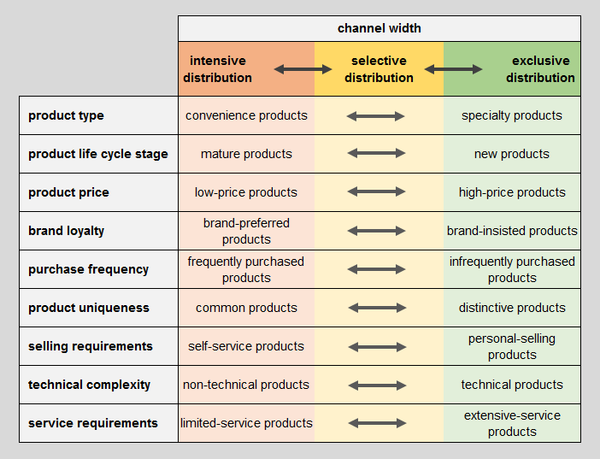Channel width
| Channel width |
|---|
| See also |
Channel width term means the number of intermediaries, entities and institutions located in all levels of the distribution channel between manufacturer and purchaser available for providing the same distribution function at different stages in the distribution channel[1].
Distribution channel characteristics
There are at least three necessary market decisions around the channel to be made. A marketer needs to decide on the[2]:
- number of the channels
- their width
- their length
The difference between channel width and channel length
While the channel length depends on the number of times a product changes its place among intermediaries before it reaches the final product, the channel width is concerned with the number of intermediaries at the particular step of the distribution channel. The channel is considered to be long when its producer is required to move the product through several intermediaries. The channel is perceived as short when the product is moved between middlemen once or twice. The channel where the manufacturer sells the products directly to the final customers is called a direct channel. Channel width can be explained as a function of the number of all wholesalers and the various means that are used. It is also a function of the number of all wholesellers and their kind[3].
Factors affecting channel width
Channel width depends on the intensity strategy implemented by a company. As a result of this decision marketing channels can be divided into narrow ones, with a small number of agents or wide channels in which the products and services are offered by the biggest possible number of intermediaries at each level. The channel width dependents on many factors such as characteristics of products for instance its lifecycle stage, uniqueness and price or customers' behavior and loyalty to the brand[4].
In other words, the decisions regarding the width of the channel are based on the market coverage intensity that the architect of the channel deems necessary to gain the desired exposure and availability. Channel designers plan market coverage density ranging from very intensive distribution through rather selective distribution to even exclusive distributive network[5].
Footnotes
References
- Dunne P., Lusch R., (2007), Retailing 8th Edition, South-Western College Pub, Massachusetts
- Keillor B. D., (2007), Marketing in the 21st Century Interactive and multi-channel marketing, volume 2, Praeger, Westport
- Lewison D. M., (1996), Marketing Management Overview, The Dryden Press / Harcourt Brace College Publishers
- Lundén B., Svensson U., (2014), Marketing for Small and Medium Enterprises, Björn Lundén Information AB., Stockholm
- Onkvisit S., Shaw J. J., (2004), International Marketing Analysis and Strategy, Prentice Hall, Essex
- Pękała W., Szopa P., (2012), Distribution Channels and Their Roles in the Enterprise, Polish Journal of Management Studies, Częstochowa
- Reid R. D., Bojanic D. C., (2009), Hospitality Marketing Management, Wiley, New Jersey
- Schmidt S., (2015), Chances and Problems of Marketing of Ecological Products, Open Publishing GmbH, Verlag
Author: Aleksandra Puchała
